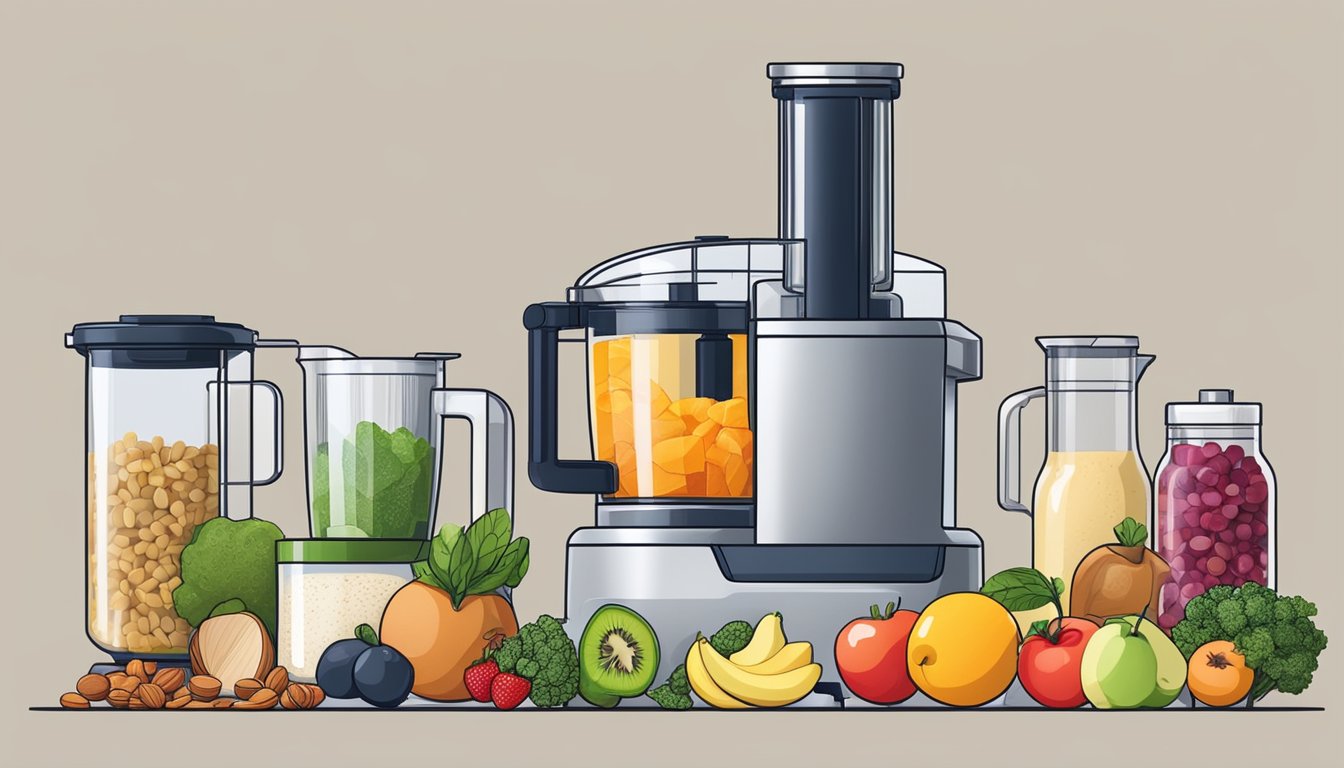A food processor is a versatile kitchen appliance that can simplify breakfast preparation. This powerful tool chops, grinds, purees, and mixes ingredients quickly and efficiently, making it ideal for creating a variety of morning meals.
Using a food processor for breakfast recipes can save time and effort while expanding your culinary options. From homemade granola to perfectly blended smoothie bowls, this kitchen gadget opens up a world of possibilities for creating delicious and nutritious morning meals. Whether you’re a busy professional or a home cook looking to experiment, incorporating a food processor into your breakfast routine can revolutionize your morning menu.
1) Carrot Ginger Soup
Carrot ginger soup is a delightful breakfast option that can be easily prepared using a food processor. This vibrant, flavorful soup combines the sweetness of carrots with the warmth of ginger, creating a comforting and nutritious start to the day.
To make this soup, begin by sautéing onions in a pot until softened. Add minced ginger and cook briefly to release its aromatic oils. Peel and slice carrots, then add them to the pot along with vegetable or chicken broth.
Once the carrots are tender, transfer the mixture to a food processor. Blend until smooth, creating a velvety texture. For added creaminess, some recipes suggest incorporating half-and-half or coconut milk.
Season the soup with salt, pepper, and a touch of sugar to enhance the natural sweetness of the carrots. Some variations include spices like turmeric for an extra flavor boost and health benefits.
Serve the soup hot, garnished with a swirl of cream or a sprinkle of fresh herbs. This breakfast soup is not only delicious but also packed with vitamins and antioxidants, making it a nourishing choice to kickstart the day.
2) Almond Butter Energy Balls
Almond butter energy balls are a quick and nutritious breakfast option that can be easily prepared using a food processor. These no-bake treats combine the rich flavor of almond butter with wholesome ingredients like oats, dates, and flaxseed.
To make almond butter energy balls, start by adding oat flour, walnuts, almond butter, dates, vanilla extract, and a pinch of salt to the food processor. Pulse the mixture until it comes together and can be easily formed into balls.
For added nutrition, consider incorporating ground flaxseed into the mixture. This ingredient provides healthy omega-3 fatty acids and extra fiber. If the mixture is too dry, add a small amount of water or extra almond butter to achieve the desired consistency.
Once the ingredients are well combined, transfer the mixture to a bowl and stir in optional add-ins like chocolate chips or dried fruit. Roll the mixture into small balls, about 1-inch in diameter.
These energy balls can be stored in an airtight container in the refrigerator for up to a week. They make an excellent grab-and-go breakfast or a satisfying mid-morning snack, providing a balanced mix of protein, healthy fats, and complex carbohydrates.
3) Cauliflower Rice
Cauliflower rice offers a nutritious, low-carb alternative to traditional breakfast grains. A food processor simplifies the preparation process, quickly transforming cauliflower florets into rice-like granules.
To make cauliflower rice, pulse cauliflower florets in the food processor until they resemble small grains. This takes just a few short pulses to achieve the desired consistency.
Cooking methods for cauliflower rice vary. One option is to sauté it in olive oil over medium heat for 5-8 minutes. Covering the pan helps steam the cauliflower, resulting in a tender texture.
For a Mediterranean-inspired breakfast, sauté the cauliflower rice with diced tomatoes and olives. Top with crumbled feta cheese and a poached egg for added protein.
Seasoning enhances the flavor of cauliflower rice. Common additions include salt, pepper, and cumin. A squeeze of lime juice at the end of cooking adds brightness to the dish.
Cauliflower rice can be prepared in advance and stored in the refrigerator for up to five days, making it a convenient option for quick breakfasts throughout the week.
4) Baba Ganoush
Baba ganoush is a Middle Eastern dip that can be enjoyed as part of a nutritious breakfast. This creamy eggplant-based spread is easy to prepare using a food processor.
Start by roasting eggplants in a 450°F oven for 45-60 minutes until tender. Once cooled, scoop out the flesh and add it to the food processor bowl.
Combine the eggplant with garlic, salt, lemon juice, and tahini in the processor. Pulse until the mixture reaches a smooth consistency.
For added flavor, some recipes suggest incorporating olive oil and cumin. Adjust seasoning to taste, blending briefly after each addition.
Serve the baba ganoush with warm pita bread, fresh vegetables, or as a spread on toast. It can be prepared in advance and refrigerated, making it a convenient breakfast option.
This protein-rich dip provides a savory alternative to sweet breakfast dishes. Its creamy texture and complex flavor profile make it a satisfying morning meal component.
5) Pesto Sauce
Pesto sauce is a versatile breakfast ingredient that can be quickly prepared using a food processor. This flavorful Italian condiment combines fresh basil, garlic, pine nuts, Parmesan cheese, and olive oil.
To make pesto, start by toasting pine nuts in a dry skillet for 2-3 minutes to enhance their flavor. Add the cooled nuts, garlic cloves, and grated Parmesan to the food processor bowl.
Pulse these ingredients until coarsely chopped. Next, add fresh basil leaves, salt, and pepper to the mixture. Process until finely chopped.
With the food processor running, slowly drizzle olive oil through the feed tube. This creates a smooth, emulsified sauce. Adjust seasoning to taste.
Pesto can be used in various breakfast dishes. Spread it on toast, mix it into scrambled eggs, or use it as a topping for savory breakfast bowls. It also pairs well with omelets or frittatas.
For a unique twist, try making pesto with other greens like spinach or arugula. Substitute walnuts or almonds for pine nuts to create different flavor profiles.
6) Hummus

Hummus is a versatile and nutritious spread that can be easily prepared using a food processor. This Middle Eastern staple makes for a delightful breakfast option when paired with other ingredients.
To make hummus, blend chickpeas, tahini, lemon juice, garlic, and olive oil in a food processor until smooth. The appliance effortlessly creates a creamy texture that would be difficult to achieve by hand.
For a breakfast-inspired twist, consider adding roasted red peppers or sun-dried tomatoes to the mix. These additions infuse the hummus with extra flavor and color.
Serve the freshly made hummus as part of a breakfast bowl. Spread it in a shallow dish and top with poached or fried eggs, diced vegetables, and a sprinkle of za’atar seasoning.
Another option is to use hummus as a spread on toast. Layer it with sliced avocado, cherry tomatoes, and a drizzle of olive oil for a quick and satisfying morning meal.
For those who enjoy meal prep, hummus can be made in larger batches and stored in the refrigerator. This allows for easy assembly of breakfast bowls or toast throughout the week.
7) Pizza Dough

Pizza dough can be quickly prepared in a food processor, making it a convenient breakfast option. The machine efficiently combines flour, yeast, salt, and olive oil in seconds.
To start, add dry ingredients to the processor bowl. With the machine running, slowly pour in warm water through the feed tube until a single ball forms.
The dough comes together in about 30 seconds. If it becomes sticky, a small amount of flour can be added to adjust the consistency.
Once processed, the dough can be removed and allowed to rise. After rising, it’s ready to be shaped, topped, and baked.
For a quick breakfast pizza, preheat the oven to 425°F (218°C). Add desired toppings to the rolled-out dough and bake for 15-20 minutes.
This method produces a crisp crust perfect for supporting savory breakfast ingredients like eggs, cheese, and vegetables. The food processor simplifies what is typically a time-consuming process.
8) Nut Milk

Homemade nut milk is a nutritious and delicious breakfast option easily created with a food processor. This versatile ingredient can be enjoyed on its own or used in various morning recipes.
To make nut milk, soak raw nuts overnight to soften them. Drain and rinse the nuts, then blend them with fresh water in the food processor until smooth. Strain the mixture through a nut milk bag or cheesecloth to separate the liquid from the pulp.
Popular nut milk options include almond, cashew, and hazelnut. Each offers a unique flavor profile and nutritional benefits. Experiment with different nuts to find your favorite.
Add natural sweeteners like dates or vanilla extract during blending for enhanced taste. For a creamier texture, include a small amount of coconut oil in the mixture.
Use homemade nut milk in smoothies, overnight oats, or as a base for breakfast cereals. It also serves as an excellent dairy-free alternative in coffee or tea. Store the fresh nut milk in an airtight container in the refrigerator for up to five days.
9) Pancake Batter
Food processors make whipping up pancake batter quick and easy. Simply add dry ingredients like flour, sugar, baking powder, and salt to the processor bowl.
Pulse a few times to combine. Then add wet ingredients such as milk, eggs, melted butter, and vanilla extract. Process until just mixed, being careful not to overmix.
For extra flavor, try adding cinnamon, nutmeg, or brown sugar to the batter. A few quick pulses will incorporate these nicely.
The food processor method ensures a smooth, lump-free batter in seconds. It’s particularly useful for making large batches of pancakes for a crowd.
Pour the batter directly from the processor bowl onto a preheated griddle or pan. Cook until golden brown on both sides.
This technique works well for various pancake recipes, including buttermilk, banana, or even savory options. Experiment with different add-ins like blueberries or chocolate chips for variety.
10) Gazpacho
Gazpacho is a refreshing cold soup that can be easily prepared using a food processor. This Spanish dish is perfect for a light summer breakfast or brunch.
To make gazpacho, start by roughly chopping tomatoes, cucumbers, bell peppers, and red onions. Place these vegetables into the food processor bowl.
Add garlic, olive oil, sherry vinegar, and a slice of bread soaked in tomato juice. The bread helps thicken the soup and gives it a smoother texture.
Pulse the ingredients until they reach a consistency between chunky and smooth. Season with salt, pepper, and cumin to taste.
For added flavor, some recipes include lemon juice or a pinch of sugar. Blend again to incorporate these final touches.
Chill the gazpacho for at least three hours before serving. This allows the flavors to meld and intensify.
Serve the cold soup in bowls or glasses. Garnish with diced vegetables, croutons, or a drizzle of olive oil for extra texture and visual appeal.
Benefits of Using a Food Processor

Food processors are versatile kitchen appliances that streamline meal preparation and expand culinary possibilities. These devices offer significant advantages for home cooks and professional chefs alike.
Time-Saving Efficiency
Food processors dramatically reduce prep time for many recipes. Chopping vegetables, grating cheese, and mixing dough become quick tasks with the press of a button. A food processor can dice onions in seconds, saving tears and effort. It effortlessly shreds carrots or cabbage for slaws and salads.
Batch cooking becomes more manageable with a food processor. Large quantities of ingredients can be processed rapidly, making meal planning easier. The speed of food processors allows cooks to prepare fresh, homemade meals even on busy weeknights.
Versatile Capabilities
Food processors offer multiple functions in one appliance. They can chop, slice, shred, puree, and knead. This versatility eliminates the need for several separate kitchen tools.
Many models come with various blade attachments for different tasks:
- S-blade for chopping and pureeing
- Shredding disc for cheese and vegetables
- Slicing disc for uniform cuts
- Dough blade for mixing and kneading
Food processors excel at making smooth dips, sauces, and spreads. They can grind nuts into butter or flour. Some models even juice fruits or whip cream. This range of capabilities encourages culinary creativity and experimentation in the kitchen.
Tips for Choosing the Best Ingredients

Selecting high-quality ingredients is crucial for creating delicious breakfast recipes using your food processor. The right choices can elevate your dishes and ensure optimal flavors and textures.
Freshness and Quality
Opt for fresh, ripe produce when selecting fruits and vegetables. Check for vibrant colors and firm textures. Avoid bruised or overripe items that may compromise taste and texture.
For eggs, look for those with intact shells and check the expiration date. Choose organic or free-range options for potentially better flavor and nutritional value.
When buying dairy products, check expiration dates and opt for items with minimal additives. Fresh milk, yogurt, and cheese can significantly enhance breakfast recipes.
Select whole grains and nuts that are properly stored to maintain freshness. Inspect packaging for any signs of damage or exposure to moisture.
Ingredient Pairings
Consider complementary flavors when selecting ingredients for your breakfast recipes. Pair sweet fruits with tangy yogurt or creamy nut butters for balanced taste profiles.
Combine different textures to add interest to your dishes. Mix crunchy nuts with smooth purees or pair soft fruits with crisp granola.
For savory breakfast options, pair eggs with fresh herbs and vegetables. Spinach, tomatoes, and bell peppers work well in omelets or frittatas.
Experiment with spice combinations to enhance flavors. Cinnamon and nutmeg complement sweet dishes, while cumin and paprika work well in savory recipes.
Common Mistakes to Avoid

Proper technique is crucial when using a food processor for breakfast recipes. Avoiding common pitfalls ensures optimal results and preserves your appliance’s longevity.
Improper Blade Selection
Selecting the wrong blade can significantly impact your breakfast preparation. For smooth purees and batters, use the standard S-shaped blade. This blade excels at blending ingredients for pancakes, waffles, and smoothie bowls.
Reserve the shredding disc for tasks like grating cheese for omelets or shredding potatoes for hash browns. The slicing disc works well for uniform cuts of fruits or vegetables for breakfast bowls.
Using the dough blade for liquid-heavy mixtures can lead to inadequate blending. Similarly, attempting to knead dough with the S-blade may result in overprocessing and tough textures.
Overfilling the Bowl
Exceeding the food processor’s capacity is a frequent error. Overfilling can lead to uneven processing and potential leaks. For most breakfast recipes, fill the bowl no more than two-thirds full.
When making smoothies or purees, stick to the “Max Liquid Fill” line marked on the bowl. This prevents spills and ensures proper blade function.
For dry ingredients like nuts or oats, fill only to half capacity. This allows room for ingredients to move freely, resulting in even chopping or grinding.
If a recipe exceeds your processor’s capacity, process in batches. This approach maintains consistency and prevents motor strain.




